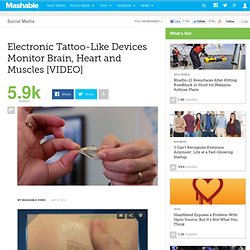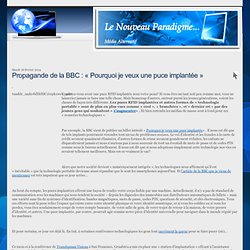

Electronic Tattoo-Like Devices Monitor Brain, Heart and Muscles. We might one day be able to monitor our bodies' internal functions — and prevent things like epileptic seizures before they happen — using a flexible circuit attached to the surface of skin.

The National Science Foundation announced Monday that researchers are working on a prototype tattoo-like device that can detect heart, muscle and brain activity. Propagande de la BBC : « Pourquoi je veux une puce implantée » Voudriez-vous avoir une puce RFID implantée sous votre peau?

Si vous êtes un tant soit peu comme moi, vous ne laisseriez jamais se faire une telle chose. Mais beaucoup d’autres, surtout parmi les jeunes générations, voient les choses de façon très différente. Les puces RFID implantées et autres formes de « technologie portable » sont de plus en plus vues comme « cool », « branchées », et « dernier cri » par des jeunes gens qui souhaitent « s’augmenter« . Et bien entendu les médias de masse sont à fond pour ces « avancées technologiques ».
Par exemple, la BBC vient de publier un billet intitulé « Pourquoi je veux une puce implantée« . Alors que notre société devient « numériquement intégrée », les technologues nous affirment qu’il est « inévitable » que la technologie portable devienne aussi répandue que le sont les smartphones aujourd’hui. Au bout du compte, les puces implantées offrent une façon de rendre votre corps lisible par une machine.
Et pour certains, ce jour est déjà là. Goodbye Roll Call, Hello RFIDs. For some reason, I have vivid memories of roll call from elementary school.

It was a daily drill that gave each student a chance to rehearse his identity by riffing on the word "here! " Whether you sang it or burped it, you had to make it memorable. Or at least, that's how I felt about it. But it's a nostalgia I may not share with my kids, as tracking devices have begun to dispose of the ritual all together.
TRANSHUMAN VISIONS - San Francisco Conference - SOLD OUT - here’s the Schedule, New Perks, Food Info - BrighterBrains.org. Biostamp temporary tattoo wearable electronic circuits by MC10. Materials scientist John Rogers and his firm MC10 have developed flexible electronic circuits that stick directly to the skin like temporary tattoos and monitor the wearer's health.

The Biostamp is a thin electronic mesh that stretches with the skin and monitors temperature, hydration and strain. Rogers suggests that his "epidermal electronics" could be developed for use in healthcare to monitor patients without tethering them to large machines. Not only would this be more convenient, but the results could be more accurate if patients were examined in their normal environment doing usual activities rather than on the hospital ward.
The Freaky, Bioelectric Future of Tattoos. Child-tracking wristbands edge us closer to a dystopian future. For those who think the NSA the worst invader of privacy, I invite you to share an afternoon with Aiden and Foster, two 11-year-old boys, as they wrap up a Friday at school.
Aiden invites his friend home to hang out and they text their parents, who agree to the plan. As they ride on the bus Foster's phone and a sensor on a wristband alert the school and his parents of a deviation from his normal route. The school has been notified that he is heading to Aiden's house so the police are not called. As they enter the house, the integrated home network recognises Aiden and pings an advisory to his parents, both out at work, who receive the messages on phones and tablets.
Goodbye Roll Call, Hello RFIDs. Scientists Develop Human-Powered Battery For RFID Implantable Chips. Posted by Kristan Harris on Jan. 24, 2014 conformal piezoelectric energy harvesting, rfid, human battery, National Academy of Science, trans-humanism, kristan t. harris, the rundown live Kristan T.

Harris | The Rundown Live Milwaukee’s Alternative News & Talk Radio The video footage above demonstrates installation of a complete, flexible, and integrated system that is capable of harvesting and storing energy from the natural contractile and relaxation motions of the heart, lung, and diaphragm. A group of United States and Chinese researchers have collaborated to created a tiny implantable batteries that feed off of human energy.
It the future, they say, it could be used to power a range of gadgets. So how piezoelectric power plants work? These will at first be sold as a good product. The National Academy of Science’s Website had this to say about conformal piezoelectric energy harvesting: Another new technology that will benefit from this is RFID. Why I want a microchip implant. With a chip under your skin, you can do everything from unlocking doors to starting motorbikes, says Frank Swain, who has been trying to get his own implant.

A few years ago, I perched on the edge of my bed in a tiny flat, breathing in a cloud of acetone fumes, using a scalpel to pick at the corner of an electronic travel card. More than 10 million Londoners use these Oyster cards to ride the city’s public transport network. I had decided to dissect mine. After letting the card sit in pink nail polish remover for a week, the plastic had softened enough that I could peel apart the layers.
Buried inside was a tiny microchip attached to a fine copper wire: the radio frequency identification (RFID) chip. My goal was to bury the chip under my skin, so that the machine barriers at the entrance to the Underground would fly open with a wave of my hand, as if I was some kind of technological wizard.